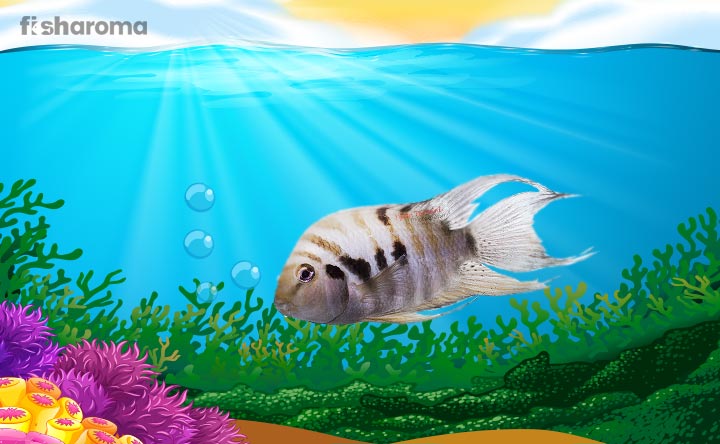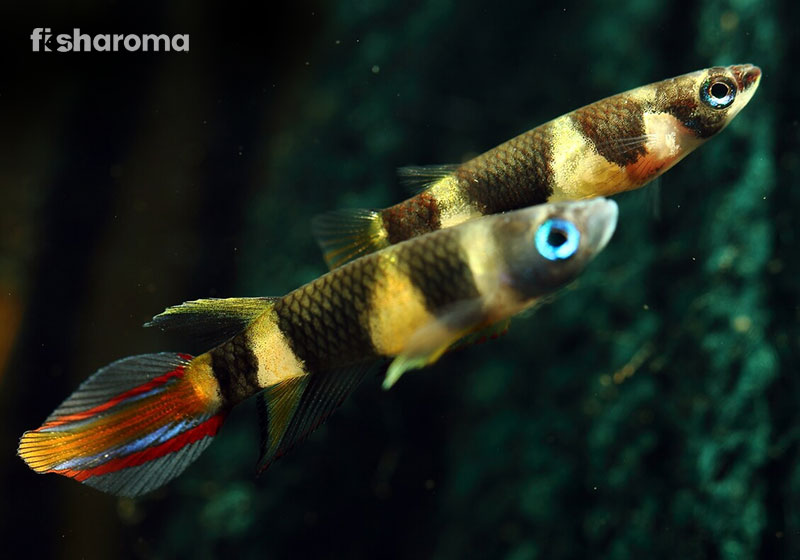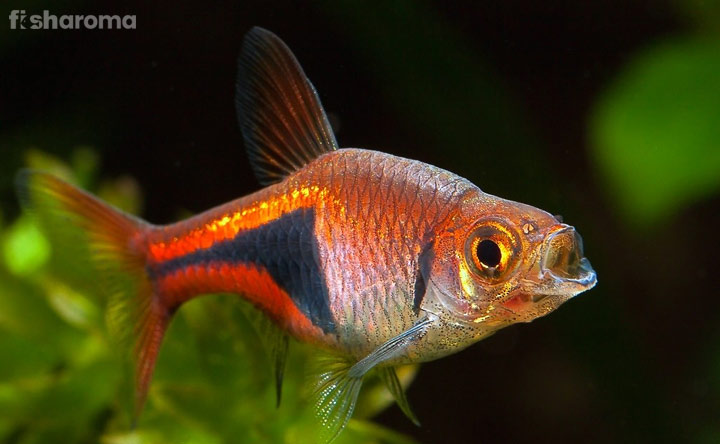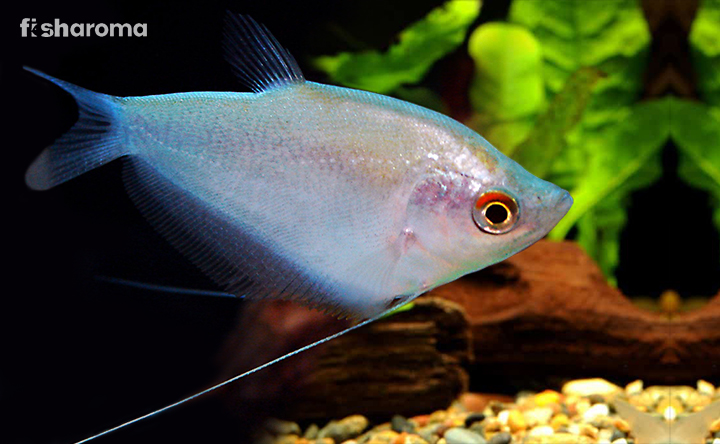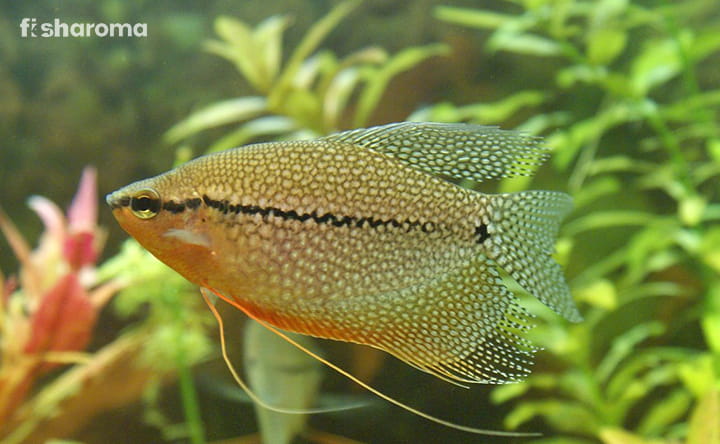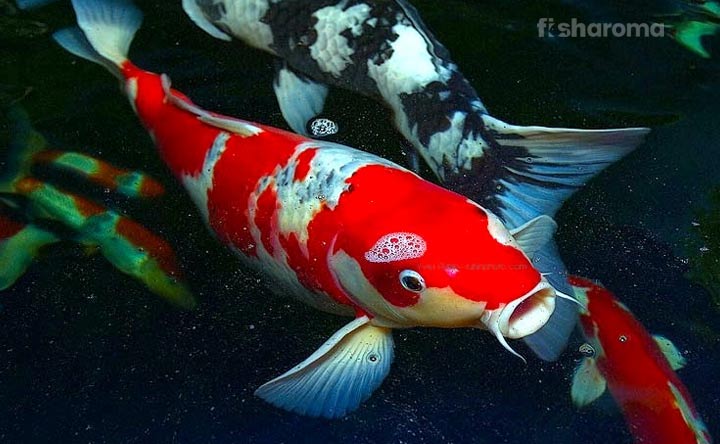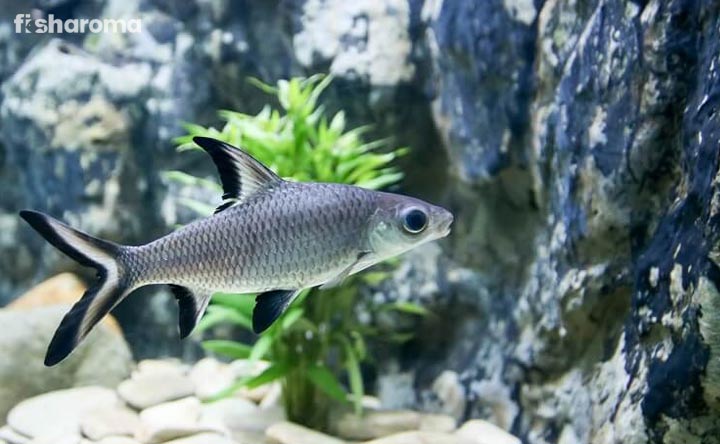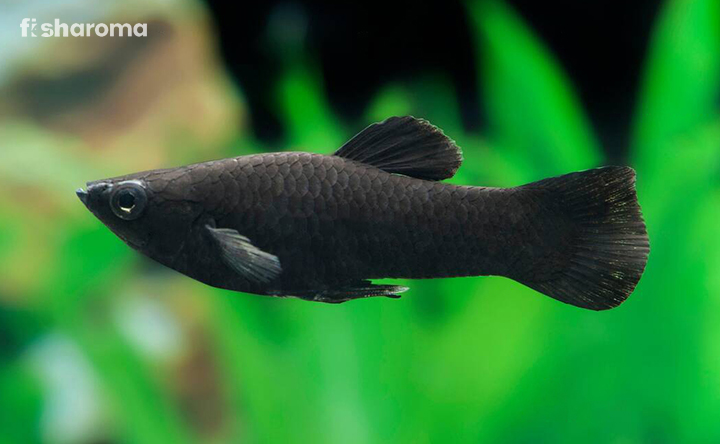Licorice Gourami: An Expert Care Guide To This Spectacularly Patterned Freshwater Fish
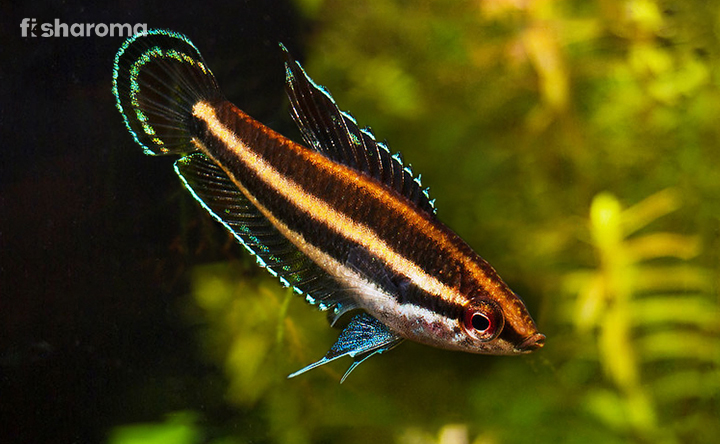
- Origin & Habitat of Licorice Gourami
- Appearance of Licorice Gourami
- Behaviour of Licorice Gourami
- Lifespan of Licorice Gourami
- Diet of Licorice Gourami
- Tank Requirements for Licorice Gourami
- Water Type for Licorice Gourami
- Compatibility of Licorice Gourami
- Breeding of Licorice Gourami
- Disease of Licorice Gourami
- Summary
Licorice Gourami is a very common and popular choice among many freshwater aquarists. These fishes have an extraordinarily hued pattern on their skins and their relatively small size adds to the liking of an aquarist.
Licorice Gouramis belong to the Macropodusinae subfamily, part of the Osphronemidae family, the family of the Gouramis.
Not only are they extremely calm and silent, but their presence will surely brighten up your mood for the jazzy and striking motifs and colours on their bodies. Additionally, they have an easy-care level.
So, if you are looking forward to having one or more than one Licorice Gourami in your freshwater tank then, you are at the right destination! Here, we will help you out with easy and expert suggestions on their care, diet, behaviour, breeding and more. expert guidance on their care, diet, behaviour, breeding and more!
So, follow through and know it all!
Key Specifications of Licorice Gourami
Licorice Gourami is an extremely appealing freshwater fish and so, if you want to have them as your pet then, let’s have a look at the table below! The following chart gives information on their basic characteristic traits.
| Scientific Name | Parosphromenus deissneri |
| Origin | Indonesia |
| Lifespan | 5-6 years |
| Colour | Silver body with black stripes and multi-coloured tails and fins. |
| Temperament | Peaceful |
| Size | Maximum 2.5 inches |
| Diet | Omnivore |
| Family | Osphronemidae |
| Compatibility | Other similar-sized, peaceful fishes |
| Tank Size | 20 Gallons |
| Care Level | Moderate |
| Water Temperature | 21.7-27.8 Degrees Celsius |
| Water Conditions | pH 3.5-6.5 |
| Breeding | Bubble nest |
Overview
Licorice Gourami (Parosphromenus deissneri), previously known as Osphromenus deissneri, is a freshwater fish which was first described in 1859 by Pieter Bleeker. These fishes belong to the Actinopterygii class and Anabantiformes order. Licorice Gourami, also spelt as Liquorice, is deemed as the “unusual Blackwater Gourami”. This is because these Gouramis inhabit tea-coloured freshwater regions of South-East Asia.
Although Licorice Gouramis are bottom-feeders, you should not confuse them with bottom-dwellers. These fishes prefer to swim near the top and the middle layer of the tank. Licorice Gouramis are generally very shy, timid and peaceable creatures. They have an eye-catching pattern on their skins and also, and these fishes have an equally gripping personality. Licorice Gouramis are also well-known for the specialised Labyrinth organs in their gills.
These fishes are quite beginner-friendly as they have an easy to moderate care level. You can keep your Licorice Gourami with other tranquil, small, quiet and slow-swimming fishes.
Nevertheless, when it to comes to having a fish as your pet then, you must pay keen attention to their care, maintenance and well-being.
Origin and Habitat of Licorice Gourami
Licorice Gourami are native to Bangka Belitung province in Indonesia. The province comprises two main islands Bangka and Belitung. Additionally, they also inhabit the Mekong River Basin in Indo-China.
Licorice Gouramis thrive in slow-streaming murky waters of the creaks and forest peat swamps in the areas which they inhabit in South-East Asia.
The tanned colour of the water they inhabit is the result of tannin production by the dense aquatic vegetation and the humic acid production by decomposing organic matters. These fishes live in regions with dense aquatic plantations, lots of rocks, crevices and caves. They populate warm, acidic and soft water areas.
Appearance of Licorice Gourami
Licorice Gouramis have multi-hued patterns on their bodies. We will have a deeper look into their colourations in the “colour” section below.
These fishes have torpedo-shaped bodies. The entire body is lined by fins. Licorice Gourami is a type of ray-finned fishes. The ventral, anal, dorsal and caudal fins are designed as webs of skin supported by bony structures called ‘rays’.
Licorice Gouramis have a specialised organ called the ‘labyrinth organ’ in their gills. These organs make the fish very hardy and resistant to several unfavourable and harsh conditions. Thanks to the labyrinth organs as they confer the fish with the ability to breathe air and directly absorb oxygen from water.
Size
Licorice Gouramis are loved by many because of their small size which makes them easy to house. These fishes can reach a maximum length of 2 to 2.5 inches given that they are properly taken care of and that their needs are diligently looked after.
Colour
Licorice Gouramis are known for the striking pattern of colours on their bodies. Their bodies are silver in colour. Black vertical stripes extend from the base of the dorsal fin to the top of the head. The entire body is walled by fins. The ventral, anal, dorsal and caudal fins have a multi-hued touch to them. They are an iridescent mixture of blue, green and red. The phenomenal colours are even more visible when the fish lies against a dark substrate.
Sexual Dimorphism
The male Licorice Gouramis are larger in size than the females. Additionally, they have more vibrant colouration to their bodies. The anal, dorsal and caudal fins are quite prominent with a strong colouration. The females, on the other hand, get paler when they approach the breeding season. Also, they have brownish bodies.
Behaviour of Licorice Gourami
Licorice Gouramis are typically very calm and shy in nature. They love to hide behind caves and rocks and so, you must include hiding places inside your Gourami tank. Male Licorice Gouramis, however, can develop territorial instincts if housed with other Gouramis of the same species or even a different species. Additionally, Licorice Gouramis survive the best in pairs.
Male Licorice Gouramis turn noticeably aggressive when the mating season approaches. This is the very reason why it is always recommended that you get a spacious tank for your Licorice Gouramis, as it will make them feel more secure and help them get comfortable with their own territories.
How fast do they swim?
Licorice Gouramis are slow swimmers and they are not very adept at hunting. You should always keep your Gourami with other slow-swimming, calm fishes as Licorice Gouramis don’t like the presence of fishes who frantically move around. These hyper-active fishes can easily intimidate your Gourami which might ultimately lead to a fight and stress out your fish.
Licorice Gouramis mainly swim near the top and the middle of the tank. They find their way to the top as it gives them easy access to surface oxygen.
Are they nocturnal?
These fishes are most active during nighttime. During the day, you will often find them hiding amidst the bushes and inside the caves. However, as they get old, they even show activity during the day. Also, as they age, they develop good hunting instincts.
Lifespan of Licorice Gourami
Licorice Gouramis can live up to 5-6 years. It all depends on the tank conditions. If you properly look after their needs then, your fish will live a long and healthy life.
Diet of Licorice Gourami
Licorice Gouramis are omnivores. You must include equal portions of meat and veggies in their diet. Make sure that you feed them once or twice a day.
Also, do check that the food you give to your fish is within their reach as these fishes have very poor hunter instincts. Therefore, if their food is not quite within their reach, other tankmates may grasp this chance of devouring the food.
If this keeps on happening on a regular basis, your Licorice Gourami may become sick due to malnutrition.
What to include in veggies?
- Cucumbers
- Spinach
- Zucchini
- Brocolli
- Peas
- Lettuce
Commercially available food:
- Algae tablets
- Fish food
They also feed on:
- Brine Shrimp
- Bloodworms
- Tubifex
- Mosquito larvae
- Daphnia
- Insects
- Zooplankton
Licorice Gouramis don’t prefer dried foods or even flakes and pellets.
Tank Requirements of Licorice Gourami
Licorice Gourami is one of the most attractive and admired types of freshwater fishes. So, if you want to have them as your pet then, you should diligently take care and look after their needs and tank requirements.
In this portion, we will share some expert suggestions with you on their tank requirements.
Tank Size
For a Licorice Gourami or a pair of them, you should get a minimum tank size of 20 gallons. When housing a group of Licorice Gouramis, a tank size of 35 Gallons will do just fine. Make sure that you are getting the right sized tank for your pet fish.
Tank Shape
Licorice Gouramis love to swim around freely. Additionally, a group of Licorice Gouramis require adequate space to establish their own territories, so, a rectangular-shaped tank is a right choice for them.
A fishbowl should be avoided as it will restrict oxygenation and also make the fish feel claustrophobic. This, in turn, might affect both their physical and psychological health.
Tank Lid
Licorice Gouramis are good jumpers. Also, they roam around near the surface of the tank. So, a tank lid is a must. If you don’t cover your tank with a lid then your tank may get contaminated with foreign harmful toxins and dust particles.
Always make sure that you are tight closing the tank lid.
Substrate
For Licorice Gouramis you should add a dark coloured substrate at the bottom of the tank. A darker substrate will enhance the beauty of your fish as its colours will be more visible against a darker background.
As substrate particles, you can use either sand or gravel. Both will do just fine.
Filter
Licorice Gouramis require a strong filtration technique for their tanks. This is required to ensure that your tank is free of any toxins and waste materials. A proper filtration system will also purify the air inside the tank and ensure adequate ventilation.
Licorice Gouramis thrive in environments with darker backgrounds. For that, you can use peat in the filters which will turn the tank water into a light brownish-black colour. Additionally, since these are naturally adapted to swimming through measured and gentle water currents, we recommend sponge air filters for that purpose.
Ornaments
If you want to give the best life to your Licorice Gouramis then, the first thing that you should do is make them feel at home. Make sure that their aquarium environment mimics their natural habitat. Licorice Gouramis are very shy creatures, so, add lots of hide-out places inside the tank. Include lots of stones, soft rocks, caves and driftwood for providing them with space to hide.
Lighting
A Licorice Gourami’s natural habitat consists of dark murky waters. To replicate this environment inside the aquarium, you should add subdued lighting. Although these fishes swim at the top layer of the tank, make sure that the lighting isn’t very bright. There should be enough covers which will restrict the entry of high-intensity lights. Overall, ensure that the tank is dimly lighted.
Presence of Flora
Licorice Gouramis require dense aquatic vegetation. You can add the following hardy-stemmed and bushy plants inside a Licorice Gourami tank:
- Indian Fern
- Bacopa Australis
- Anubias Nana
- Cryptocoryne Parva.
Since Licorice Gouramis are shy and prefer to hide themselves to feel safe and comfort themselves, you should also definitely add floating aquatic plants which would act as covers. These include Duckweed, Hornwort, Java Moss, and Amazon Frogbit.
You can also add dried leaves which include Cattapa leaves. These leaves will help replicate the natural environment of these fishes.
Cleaning Method
First off, a strong filtration mechanism is important to ensure that your tank keeps clean and free of any toxins and waste particles.
Additionally, make sure that you have made the habit of changing 10% of the tank water once or twice a week. To clean the inside of the tank’s walls, use a soft sponge. You can also use metal or plastic scrappers to remove the algae stuck on the glass walls.
Furthermore, an aquarium vacuum cleaner will clean and remove any accumulated waste and food particles hidden within the substrate layers.
Ensure that you are cleaning your fish tank proficiently.
Water Types for Licorice Gourami
If you want to have Licorice Gouramis as your pet then, you must take the right measures to maintain the proper water conditions inside the tank.
Before you are introducing your fish to the tank, make sure that you are fully cycling the aquarium.
Come let’s have a look at their water requirements.
Water Temperature
Licorice Gouramis thrive the best in warm water temperatures. You should maintain the tank water temperature between 21.7-27.8 Degrees Celsius.
Use the best heater and aquarium thermometer to maintain, regulate and check your aquarium temperature.
pH Level
For a Licorice Gourami tank, you must maintain the water pH between 3.0 and 6.5. These fishes thrive the best in acidic waters. Make sure that you are maintaining the proper pH level inside your tank.
Hardness
For a Licorice Gourami, ensure that the water hardness is maintained between 1 to 4 dKH. Licorice Gouramis always prefer soft water.
Water Flow Rate
Licorice Gouramis prefer to swim through gentle water currents. They love roaming around in areas that have a measured flow rate. You should install a pump inside your tank to maintain a steady flow rate of water.
Compatibility of Licorice Gourami
Licorice Gouramis are very shy and calm creatures. The male Licorice Gouramis may show territorial aggressiveness towards its own kind. Nevertheless, these fishes live the best in groups and communities. To avoid territorial fights, make sure that you provide your Gourami with adequate space to swim around freely and explore.
You should keep other similar-sized and equally peaceful tankmates inside your Gourami tank. Strictly avoid adding aggressive, larger-sized and territorial fishes to your tank, as they might pose a threat to your Gourami’s life.
Additionally, you should pay attention to whether any of the tankmates are fin nippers. Since Licorice Gouramis are slow swimmers and are not active hunters, there are high chances that the fin nippers will nip at the Gourami’s fins which will ultimately lead to fatal injuries.
Suitable Tank Mates
- Sparkling Gourami
- Dwarf Gourami
- Celestial Pearl Danio
- Guppy Fish
- Corydoras Catfish
- Neon Tetra
- Ember Tetra
- Kuhli Loach
- Phoenix Rasbora
- Chili Rasbora
Unsuitable Tank Mates
- Tiger Barb
- Flowerhorn Cichlid
- Jaguar Cichlid
- Silver Arowana
- Oscar Fish
- Red Tail sharks
- Other aquarium Fin nippers
You should avoid adding shrimps and snails to your tank, as Licorice Gouramis are known to attack and feed on smaller crustaceans.
Breeding of Licorice Gourami
Licorice gouramis are cave spawners. The female Licorice Gouramis will search for a hiding spot like a cave or under the rocks to lay the eggs. Breeding Licorice Gourami is quite an easy process. You should get a separate breeding tank for this purpose.
Ensure that you add lots of hiding places inside the tank which include upturned coconut shells and plant pots, caves, non-toxic plastic pipes, soft rocks and stones. You can also plant some Java Moss inside the breeding tank and cover the surface of the tank with freshwater aquarium floating plants. These will confer the female Licorice Gourami with a sense of protection.
Breeding Parameters
Install a sponge filter inside the breeding tank. The water level inside the breeding tank should be decreased by a level of 4 inches. Make sure that you elevate the temperature of the water by 2 degrees per day. The optimum temperature inside the tank, for the breeding purpose solely, should be 28 Degrees Celsius.
To actuate the spawning, you should feed your Licorice Gouramis often. Include live worms and tubifex in their diet.
Breeding Technique
Once the Licorice Gouramis are ready to mate, you’ll notice that the male fish has built a bubble nest over the artificial hide-out place (caves/coconut shells) inside the tank. When you observe this, you should introduce the female fish to the breeding tank as they will start spawning in no time.
As the male fish will try to tempt the female fish, the pair will start to embrace each other. The eggs will be laid by the female fish and the milt will be secreted by the male fish simultaneously. The eggs are then trapped by the mating pair in the bubble nest.
You can expect around 40-100 eggs to be laid. Once the spawning is done, you should remove the female fish from the breeding tank as they may prey on the eggs. The male fish will fertilize the eggs, and protect and look after them till the time they hatch.
How should you take care of the fries?
The eggs generally hatch within 24-72 after spawning. The fries start to swim freely within 5-7 days after hatching. Once the eggs hatch, make sure to remove the male fish from the tank.
The nursery tank, which now only consists of the fries, should be well taken care of. Ensure that the water quality is at its finest. Install proper filtration techniques to make sure that the water is purified at regular intervals and that the tank is properly ventilated.
Also, pay attention to the fact that the temperature above the surface of the water is warm as it is essential for the development of labyrinth organs.
Feed the fries live infusoria and baby brine shrimps.
Yet another way of understanding whether your Licorice Gouramis are ready to mate is by paying heed to their colourations. The male fish will develop strong and vibrant colourations, whereas, the female fish will lose the colours and stripes on her body and grow paler.
Disease and Treatment of Licorice Gourami
Licorice Gouramis are quite hardy and the credit goes to their labyrinth organs. However, let’s not eradicate the fact that your Licorice Gourami might fall prey to certain common freshwater diseases. Let’s have a look at them and their respective treatments.
Ich
This freshwater disease is caused by water-borne parasites. You will notice whitish spots all over your fish’s body and tail. The infected fishes will also lose their appetite and act lethargic.
To treat, first separate the fish into a clean tank. Then, ensure that you are taking the right measures to make the previous tank dirt-free. Change the tank water frequently. Use a sponge or a scraper to clean the glass walls and remove stains or excess algae.
Switch to a new and efficient filtration system if need be. Do consult a vet to look for further solutions.
Tail, Fin Rot and Dropsy
These are common bacterial infections. The affected fish will lose colouration on its body. Also, the tail starts rotting, that is, it starts losing tissues.
Again, these types of diseases are a result of poor tank and water conditions. Make sure that you change 25% of the tank water at least once a week. Keep the tank clean and use a strong filtration mechanism.
Do consult an expert vet if the infection takes a serious turn.
Holes in the Head
Holes in the Head are caused by certain bacteria which infect freshwater fishes. When your fish is infected, you’ll notice small cavities on and near its head.
To treat this disease, make sure that you are keeping the tank and the water clean enough. Install a powerful filtration system. Change the tank water at regular intervals. Medications include tetracycline and vitamin supplements.
Consult a vet for expert and accurate treatment.
Fungal Disease
If your Licorice Gourami is infected by a freshwater fungus, then you’ll notice greyish-white spots all over the fish’s body.
As always, make sure that the tank conditions are maintained at their optimum.
Apart from these, if your tank contains fin nippers then, they may pose a serious threat to your Licorice Gourami’s life. The fin nippers will nip at the fish’s fins which will lead them to get bruised, or injured. Your Gourami is especially at risk here since they are slow swimmers. The injuries will lead to severe stress, psychological and physical distress and ultimately death.
So, avoid keeping fin-nippers in your tank. If your fish has already been affected, you should definitely and immediately consult a vet for an efficient mode of treatment.
Summary
On a closing note, if you are planning on including a Licorice Gourami in your family then, let us tell you that you have made an excellent choice! These fishes will not only adorn your freshwater tank, but their presence will also alleviate your mood.
As we have already seen before, Licorice Gouramis are extremely stunning with an admirable persona. Additionally, due to their small size, they are preferred by many beginner aquarists as they can easily house an adult Gourami in nano or a standard-sized tank.
Also, when it comes to breeding, it is not even nearly a herculean task. You can easily breed these Gouramis and add more awesomeness to your tank!
So, yes, all the best as you go ahead with your decision of getting a Licorice Gourami for your freshwater aquarium! They will indeed make a great company and you will absolutely love and cherish their presence.
Similar Care Guides
If you have found this article helpful enough then, do check out other similar articles on our website.
- Care guide for Zebra Danio: As the name suggests, these fishes have zebra-patterned stripes on their body which makes them stand out. Additionally, they are loved by aquarists because of their super-friendly and peaceful nature and the credit also goes to their small size.
- Care Guide for Gold Gourami: These Gourami species have a very bright and pleasant hue to their skins. Aquarists love to have them as their pets. These fishes are indeed a treat to the eyes! They are good community fishes with a pacific nature. Additionally, they are also very easy to take care of!
- Care Guide for White Cloud Mountain Minnow: That is such a massive name, isn’t it? However, unlike their names, these fishes are quite small in size, very timid and peaceful in nature. They won’t pose any trouble to beginner aquarists. These fishes have a metallic sheen to their skin which makes them even more attractive.

